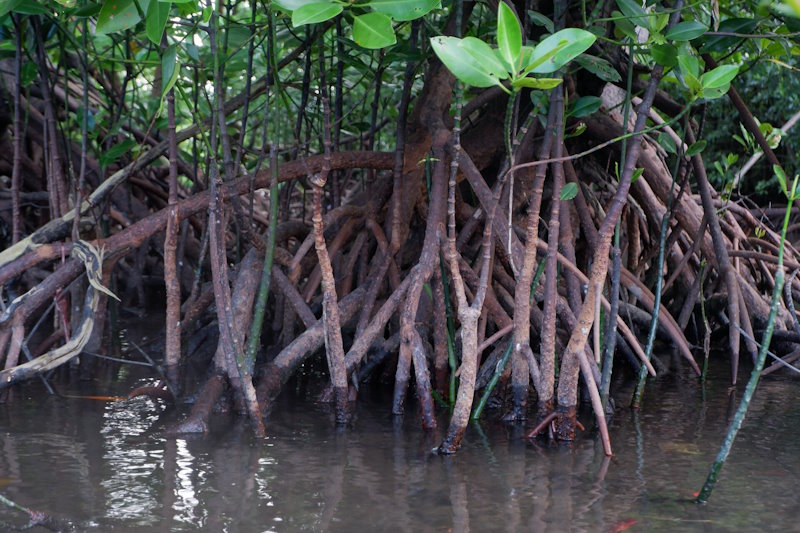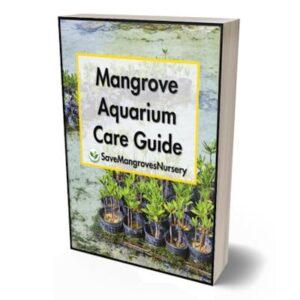
Maintaining a healthy and vibrant aquarium is both an art and a science. When it comes to growing mangroves, the substrate you choose and how you care for it can make all the difference. As a seasoned aquarium enthusiast, I’ve learned a thing or two about keeping substrates in top shape to support these incredible plants.
In this blog post, I’ll share my best tips and tricks to ensure your mangroves thrive and transform your aquarium into a stunning underwater oasis.
Understanding the Importance of Substrate for Mangroves
Before diving into the tips, it’s essential to understand why substrate matters so much for mangroves. The substrate serves as the foundation for your mangroves’ root systems, providing stability, nutrients, and support for healthy growth. Choosing the right substrate and maintaining it properly can lead to:
- Robust root development
- Improved water quality
- Enhanced aesthetic appeal
- Healthier aquarium inhabitants
🛑 Mangrove Fact: Mangroves can grow extensive root systems that not only anchor them firmly but also help filter and purify water, benefiting the entire aquarium ecosystem!
Tip 1: Choose the Right Substrate Material
Selecting the appropriate substrate is the first and most crucial step in setting up your aquarium for mangroves.
Best Substrate Options for Mangroves
- Sand
- ✅ Good: Mimics natural coastal environments where mangroves commonly grow.
- ✅ Good: Allows for easy root penetration and expansion.
- ❌ Bad: Can compact over time, restricting water flow and oxygenation if not maintained properly.
- Mud or Clay
- ✅ Good: Rich in nutrients essential for mangrove growth.
- ✅ Good: Provides excellent support for root systems.
- ❌ Bad: Can create cloudy water conditions if disturbed frequently.
- Gravel
- ✅ Good: Allows for adequate water circulation around roots.
- ✅ Good: Easy to clean and maintain.
- ❌ Bad: May not provide enough nutrients on its own; supplemental fertilization might be necessary.
- Mixed Substrates
- ✅ Good: Combining sand and gravel can offer the benefits of both materials.
- ✅ Good: Enhances aesthetic appeal with varied textures.
- ❌ Bad: Can be challenging to clean due to differing particle sizes.
Personal Anecdote: When I first started growing red mangroves, I experimented with a sand and gravel mix. The sand provided a natural look, while the gravel ensured proper water flow around the roots. My mangroves flourished, and the tank became the centerpiece of my living room!
Pros vs. Cons Summary
Pros:
- ✅ Proper substrate choice promotes healthy root development and plant growth.
- ✅ Enhances the natural look and feel of your aquarium.
Cons:
- ❌ Wrong substrate can hinder growth and make maintenance more difficult.
- ❌ Some substrates may require additional supplementation or care.
Tip 2: Prepare Your Substrate Properly
Once you’ve chosen the right substrate, proper preparation is key to setting the stage for healthy mangrove growth.
Steps for Substrate Preparation
- Rinse Thoroughly
- Remove dust and debris by rinsing the substrate until the water runs clear.
- This prevents cloudiness in your aquarium once filled.
- Layer Strategically
- Create layers if using mixed substrates; place heavier materials like gravel at the bottom and lighter ones like sand on top.
- This encourages natural filtration and root penetration.
- Add Nutrient Supplements
- Incorporate root tabs or natural fertilizers to enrich nutrient-poor substrates.
- Ensures mangroves have access to essential minerals from the start.
- Level Appropriately
- Maintain an even substrate depth, typically 2-4 inches, to support root systems adequately.
- Prevents uneven settling and promotes uniform growth.
Good vs. Bad
Good:
- ✅ Proper preparation leads to a stable and nutrient-rich environment for mangroves.
- ✅ Reduces the risk of initial water cloudiness and imbalances.
Bad:
- ❌ Skipping preparation steps can result in poor plant health and water quality issues.
- ❌ Inadequate layering may cause substrate compaction or poor root development.
🛑 Fun Fact: Did you know that mangroves can store fresh water in their tissues, allowing them to survive in high-salinity environments? This unique adaptation makes them incredibly versatile and resilient!
Tip 3: Maintain Optimal Substrate Conditions
Maintaining your substrate is an ongoing process that ensures long-term health and vitality for your mangroves.
Regular Cleaning Practices
- Use a Gravel Vacuum
- Gently remove debris and waste without disturbing the roots.
- Perform this during routine water changes to maintain cleanliness.
- Avoid Overfeeding
- Excess food can accumulate in the substrate, leading to nutrient spikes and algae growth.
- Feed aquarium inhabitants appropriately to minimize waste.
- Monitor Compaction
- Gently stir sand substrates periodically to prevent anaerobic pockets and promote oxygenation.
- Be cautious around mangrove roots to avoid damage.
Pros and Cons
Pros:
- ✅ Regular maintenance keeps water parameters stable and supports healthy plant and animal life.
- ✅ Prevents buildup of harmful substances like ammonia and nitrites.
Cons:
- ❌ Neglecting substrate care can lead to poor water quality and unhealthy conditions for mangroves and aquarium inhabitants.
- ❌ Over-cleaning can disrupt beneficial bacteria colonies essential for biological filtration.
Personal Anecdote: I once went on vacation and entrusted my aquarium to a friend who, despite best intentions, overfed my fish. Upon return, I found the substrate clogged with uneaten food, leading to cloudy water and stressed plants. It took some diligent cleaning and water changes, but the mangroves bounced back, proving their resilience!
Tip 4: Monitor and Adjust Water Parameters
Your substrate and water conditions are closely linked. Keeping an eye on water parameters helps ensure your substrate remains conducive to mangrove health.
Key Parameters to Monitor
- pH Levels
- Mangroves prefer a pH between 6.5 and 8.0.
- Regular testing helps maintain this balance.
- Salinity
- Depending on your setup (freshwater, brackish, or saltwater), maintain appropriate salinity levels.
- Use a refractometer for accurate measurements.
- Nutrient Levels
- Test for nitrates, nitrites, and ammonia regularly.
- Healthy substrate helps keep these levels in check.
- Temperature
- Maintain a consistent temperature between 75°F and 85°F.
- Fluctuations can affect both substrate condition and mangrove health.
Good vs. Bad
Good:
- ✅ Proper monitoring ensures a stable and healthy environment for mangroves and aquatic life.
- ✅ Allows for early detection and correction of potential issues.
Bad:
- ❌ Ignoring water parameters can lead to unfavorable conditions and stressed plants.
- ❌ Inconsistent conditions may cause substrate deterioration and poor root health.
🛑 Mangrove Fact: Mangroves play a vital role in coastal ecosystems by preventing erosion and providing habitats for numerous marine species. Bringing them into your aquarium helps mimic these natural benefits on a smaller scale!
Tip 5: Use Live Red Mangroves from Trusted Sources
The quality of your mangroves significantly impacts how well they adapt and thrive in your aquarium setup.
Why Choose Live Red Mangroves from Save Mangroves Nursery?
- Health and Vitality
- Our mangroves are carefully cultivated to ensure they are robust and ready for aquarium life.
- Healthy plants establish quicker and contribute positively to your tank’s ecosystem.
- Adaptability
- Suitable for saltwater, freshwater, and brackish tanks, offering versatility for various setups.
- Adapt well to different substrates when properly cared for.
- Convenient Shipping
- We ship daily to all 50 states, ensuring your mangroves arrive fresh and ready to plant.
- Secure packaging protects plants during transit for optimal condition upon arrival.
- Expert Support
- As fellow aquarium enthusiasts, we offer guidance and support to help you succeed with your mangroves.
- Access to resources and tips for ongoing care and maintenance.
Pros and Cons
Pros:
- ✅ High-quality plants increase the chances of successful growth and integration.
- ✅ Reliable shipping and support provide peace of mind and convenience.
Cons:
- ❌ Purchasing from unreliable sources may result in unhealthy or unsuitable plants.
- ❌ Lack of support can make troubleshooting and care more challenging.
Personal Anecdote: When I first ordered mangroves from Save Mangroves Nursery, I was impressed by the quality and health of the plants upon arrival. They settled into my aquarium seamlessly, and within weeks, I noticed improved water clarity and happier fish. The support team was also incredibly helpful, answering all my newbie questions with patience and expertise.
Maintaining your substrate in top shape is fundamental to cultivating healthy and thriving mangroves in your aquarium. By choosing the right substrate material, preparing and maintaining it properly, monitoring water parameters, and sourcing quality mangroves, you set the stage for a beautiful and balanced aquatic environment that benefits all its inhabitants.
How Do I Choose My Very First Plant?
So you have learned about the incredible benefits of adding mangrove plants to your tank, but you still don’t know which exact plant to add to your specific tank size?
Don’t worry, because we’ve created an easy Step-by-Step guide to help you with your selection process.
Click the button below to find out which plant is perfect for your aquarium.

 Cart is empty
Cart is empty 
